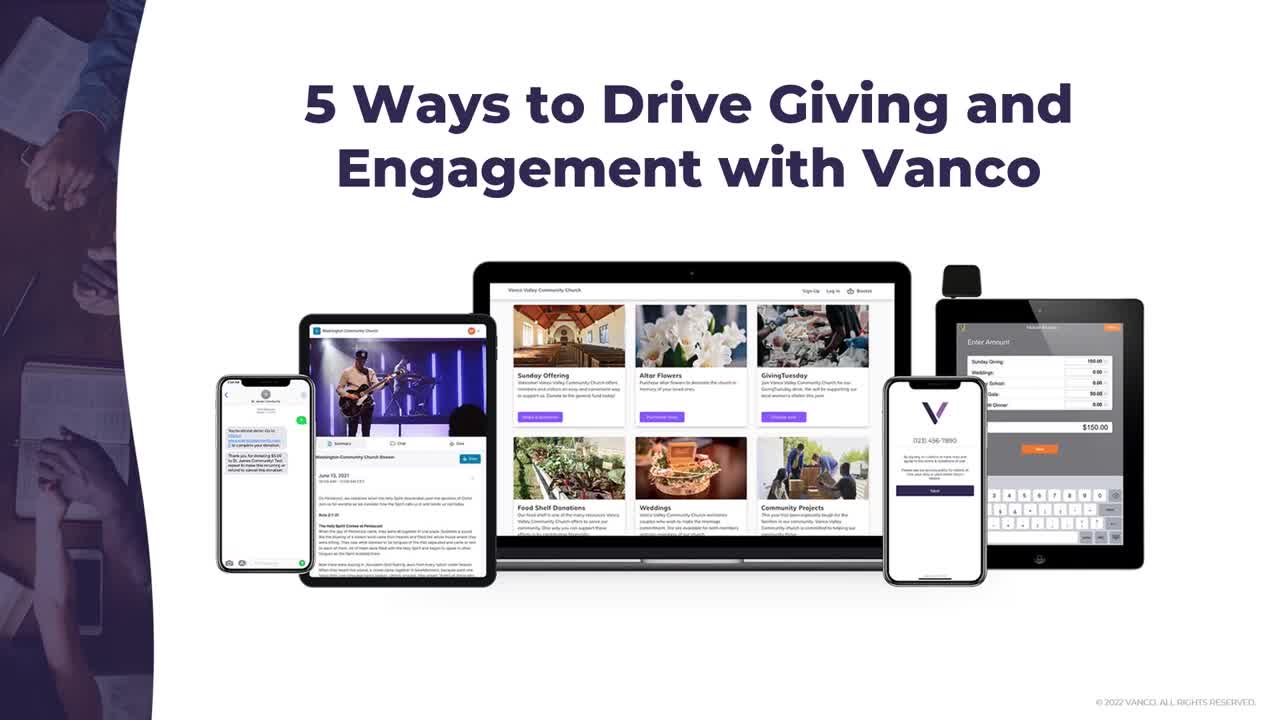
Many churches used digital tools for worship during the COVID-19 pandemic. According to Christian Standard, before 2020, only about 22% of U.S. churches livestreamed their services, but by the start of the COVID-19 pandemic, 97% were offering some form of online worship. The big jump in the use of technology in churches shows how important digital tools are for church growth. And beyond livestreaming services, other innovative church tech solutions can improve many aspects of church life.
This report explores ways technology and tools can enrich worship experiences, improve community engagement and streamline church operations. It also highlights the benefits of church digital transformation, real-world examples and best practices for implementation.
Table of Contents
- The Benefits of Using Technology in Churches
- Key Technology Tools and Solutions for Churches
- Best Practices for Integrating Technology
- Case Studies and Success Stories
- Challenges and How to Overcome Them
- Frequently Asked Questions
- Final Thoughts
Too Busy to Read? Listen to the Key Takeaways
Get the key takeaways by clicking to listen the podcast summary now!
The Benefits of Using Technology in Churches

A church tech transformation can provide benefits in many areas, from communications to operations.
Enhanced Worship Experiences
Modern technology can create a complete digital worship experience – services are more accessible and engaging without replacing the sacred atmosphere. By integrating digital tools thoughtfully, churches can reach more people and enhance participation in worship.
Digital Worship Tools
Livestreaming and online worship platforms enable members to join services remotely. This was important during the pandemic, and continues today. In 2023, REACHRIGHT found that more than 20% of church members attended an online service at least once a month and many attend online regularly. Digital tools for worship help churches extend their congregations beyond physical walls, allowing homebound or distant individuals to gather in real time.
Multimedia Presentations
Visual and audio technology – from projection screens to worship presentation software – enrich in-person services for those in the sanctuary. Churches can display song lyrics, Bible verses, videos and live camera feeds of the preacher or musicians. By incorporating multimedia, churches create a more immersive worship experience and engagement. Everyone can follow along with the lyrics or scripture, and sermons come to life with supporting images or clips.
Improved Community Engagement
Beyond Sunday services, tech solutions for community engagement help churches build community throughout the week. Churches can stay connected with members, reach new people and encourage generosity by meeting people where they are – online.
Social Media Strategies
Social networks have become the new town square for outreach. An overwhelming majority of church members are on social media, so it’s a great first step in church online engagement. FellowshipOne reports that:
- 71% of churches say social media is one of their most effective communication methods (second only to their own websites).
- Facebook is the most useful platform for 85% of churches.
- Only about 15% of churches use Twitter.
- 15% use Instagram.
Through Facebook pages, groups and live videos, churches can share inspirational content, event updates and interact with members daily.
Online Giving Platforms
Encouraging generosity is easier and more effective with online giving options. Allowing members to give via mobile app or website is convenient and can increase overall giving. Research by Carey Nieuwhof shows churches that accept donations online see a 32% increase in overall giving on average. And the option to set up recurring gifts can give churches more reliable income streams.
Increased Operational Efficiency
Churches must run smoothly every day so leaders can spend more time with people. Technology can help with that. Christian Standard found that many churches use technology to do important jobs, such as store member data (91% of churches), check in children (85%), run event registration (68%) and manage donation records and reports (68%). Automating these processes reduces errors and effort and helps pastors and ministry leaders understand giving trends and attendance patterns. Staff and volunteers spend less time doing paperwork and more time on ministry.
Key Technology Tools and Solutions for Churches
Today, there are many tools available to help churches meet their goals – for worship, giving, engagement and operations. But how do churches use these tools? Keep reading for details.
Digital Worship Tools
Technology in worship services includes tools that make online or tech-enhanced worship easier. Many churches use both technology and traditional approaches by combining online elements and in-person services. For example, a church might livestream its Sunday service on YouTube or Facebook Live while also using interactive features for those watching at home (live chat, prayer request forms, etc.).
Church technology integration is important. The best digital worship tools connect to other church systems like online giving and member databases. When a service is livestreamed, churches can include on-screen prompts or links for viewers to give offerings online. This creates a seamless experience where someone moved by the worship or message can respond in real time, no matter where they are. Vanco offers a tool that integrates chat, livestreaming and giving.
Online Giving Platforms
Online giving platforms help churches receive tithes and offerings electronically, through credit or debit cards, ACH bank transfers, text messages or mobile apps. Vanco’s platform is used by over 25,000 churches across the U.S. Check out the video below to see how it works in just a few minutes!

Vanco’s system is a good example of how online giving for churches can simplify the process for members and church staff. With an online giving platform, churches can set up:
- A secure giving page on their website
- A church-branded mobile app for donations
- Text-to-give capabilities
- Kiosks or card readers for in-person use
- Instant receipts and easy year-end giving statements
From a financial management perspective, modern church giving platforms offer robust tools and features, such as:
- Reporting: Real-time dashboards provide key information at a glance.
- Integration: These platforms work with other accounting or church operations software.
- Analytic insights: Church leaders can track trends in generosity or lapsed givers to follow up with.
- Security: Reputable vendors use encryption to protect donors’ data and ensure transactions are safe.
- Giving options: Some platforms enable donors to cover transaction fees, so more of each gift goes to the church.
Overall, adopting an online giving platform is one of the first steps many churches take in their digital transformations because people rarely carry cash or checks anymore and making giving easier produces higher and more steady donations.
Engagement Apps
To engage members outside of Sunday services, churches use social and mobile platforms tailored for community building. Here are a few ways to use apps for engagement.
- Facebook Pages and Groups are a common way churches foster online community. A public Facebook Page lets the church broadcast announcements, videos and devotional content to followers (including those who may not attend in person), while private Facebook Groups can serve as virtual small groups or prayer chains for members.
- Some churches use apps like WhatsApp or GroupMe to host small group chats during the week, or church-specific community apps (for example, some ChMS include a mobile app where members can connect).
- Some churches are using Instagram for visual storytelling with photos from events, volunteer work or inspirational graphics. Youth ministries use Instagram and even TikTok to reach teenagers in creative ways (short encouraging videos, challenges, etc.).
- Dedicated church community apps and platforms like Band (originally for team communications) as a place for church members to share prayer requests and updates in a moderated space.
- A few tech-savvy churches use Discord to create online community servers especially when meeting in person is difficult.
For help navigating these options, check out a social media strategy guide. For example, Vanco offers a “Complete Guide to Building a Church Instagram Strategy” and free downloadable content packs (with over 100 pre-made social post templates).
Church Operations
Digital tools for church administration – including church management software (ChMS) – are a game-changer for efficiency. ChMS solutions include ACS Realm, Planning Center, or Church Windows. Over 80,000 churches use Planning Center as their ChMS. These tools help churches organize member data, communications, scheduling and contributions in one place. By replacing spreadsheets and paper files, a good ChMS saves hours of administrative work each week on common tasks such as:
- Tracking attendance
- Managing donations
- Following up with visitors
- Coordinating volunteers
- Sending bulk communications (emails/texts)
Vanco and similar providers integrate their tools with ChMS. For example, Vanco’s giving system connects with Realm (ACS Technologies’ ChMS) and Church Windows, automatically posting contributions into member records. This integration saves administrative time and ensures accurate contribution records.
Best Practices for Integrating Technology
Integrating new tech into church life can be challenging without a plan. Here are some best practices to ensure a smooth and effective transition.
Provide Training and Support
Implementing new technology only helps if the team knows how to operate it.
- Offer workshops and online tutorials, or invite an expert for a demo. Use the resources many vendors (like ChMS or giving platform providers) offer, such as free training webinars and customer support.
- Create a culture where it’s okay to ask for help and learn together.
- Set clear procedures, do trial runs and write simple how-to guides or checklists to empower volunteers to use technology.
- Introduce one new technology at a time, for example, start with a Facebook page, then introduce online giving and add livestreaming. Train teams on each tool along the way.
- Lean on the tech-savvy individuals in your congregation. Build a volunteer “tech team” that can provide ongoing support. Set up a “tech kiosk” where someone can walk less tech-savvy folks through installing the app or setting up a recurring gift.
Maintain Balance
Church is about spiritual growth and relationships, not gadgets and screens.
- Continue to encourage those who are able to gather in person for the sake of fellowship (for example, by hosting periodic “all-church” in-person events or small group meetings).
- Ask members to silence phones or refrain from texting during sermons to keep people present and attentive. Some churches hold “device-free” prayer retreats where members can unplug and connect with God without distraction.
- Find out how tech is affecting your congregation. Are the screens helpful or too busy? Is the volume or style of music appealing to most or causing some to stay away?
- Stress the ethical use of technology, teaching congregants (especially youth) about responsible and moral use of technology. This might involve guidance on social media conduct or internet usage that aligns with Christian values.
Emphasize Security and Privacy
This is a critical best practice area, especially when dealing with online giving and church databases that contain personal information.
- Any online giving or payment system should comply with the Payment Card Industry Data Security Standard (PCI DSS). Using a PCI Level 1-compliant service (the highest level) means the provider has passed rigorous audits for protecting cardholder data.
- Never attempt to collect or store sensitive financial data on your own – always rely on reputable third-party processors using proper compliance tools.
- Only authorized staff and volunteers should have access to sensitive member data. Many ChMS allow you to customize permissions, for example, so a volunteer small group leader can see the names and phone numbers of their group members but not everyone’s giving records.
- Document a privacy policy for your church. Explain what data you collect and how you use it.
- If your livestream cameras are showing the faces of the congregation, especially children, always obtain consent. Some churches have camera-free zones or announce that by attending in the main auditorium members consent to possibly appear on camera.
Protect Your Data
Churches might seem like unlikely targets for hacks, but they handle a lot of personal data and money, so they need to be as diligent as any organization.
- Partner with established tech providers, who can do most of the heavy lifting for security.
- Keep all software updated to patch vulnerabilities.
- If you have Wi-Fi at church, secure it with a password or have a separate guest network for attendees.
- Train staff on basic cyber safety: recognizing phishing emails, using strong passwords, etc., so the church doesn’t fall victim to a preventable breach.
Case Studies and Success Stories
Seeing is believing. Here are a few real-world examples of churches that implemented technology successfully .
Livestreaming Boosts Attendance and Giving
A medium-sized church in Arizona began livestreaming their Sunday services in 2018. A first, only a few dozen people watched online, but by 2021 the church was reaching thousands weekly via Facebook Live and YouTube. Surprisingly, instead of reducing in-person turnout, the online outreach acted as a “front door” for newcomers. Overall attendance (combining in-person and online) grew by about 50%, and the church’s annual giving increased as well. They also enabled a feature for viewers to click a “Give” link during the livestream, making participation in the offering seamless for remote worshipers.
Social Media Engagement Success
A mid-sized church in Texas pushed to improve its social media and online content. They started posting daily scriptures and uplifting quotes and actively interacted with comments. Over a year, their Facebook followers grew significantly, and they noticed more unchurched locals joining their online discussions. When they promoted their Easter services through Facebook Events and ads, the Easter attendance hit a record high. By treating their Facebook page almost like a second campus, the Texas church extended hospitality and outreach online and saw real impact.
Vanco Helping Churches Thrive
Across the country, thousands of churches have partnered with Vanco for online giving and seen big improvements. Vanco’s data shows that on average, churches grow their online giving by 159% after adopting its tools. For example, a pastor in Illinois used Vanco’s online giving tool and promotional tools to help the church grow. Vanco reps helped him with questions and white-glove service to make online giving easy.

If you’re interested in checking out Vanco’s online giving for yourself, you can learn more about their church donation tools here.
Challenges and How to Overcome Them
Use of technology in churches can be challenging. Identify the obstacles your church faces and address them proactively.
Budget Constraints
Many churches operate on tight budgets and investing in new technology can seem cost-prohibitive. Buying screens, computers, software subscriptions, or better internet service all cost money. To overcome this, start small and try to consider the long-term benefits.
- Begin livestreaming with just a smartphone and a free social media platform before gradually upgrading your equipment.
- Use open-source or free versions of software (like a basic free ChMS) to meet some of your needs at low to no cost.
- Some tech investments actually save money over the long term (for example, online giving can pay for itself through higher donations and digital communications can save printing and mailing costs).
- Seek donations or grants specifically for technology.
Resistance to Change
It’s common for some church members and staff to be concerned about new tools and methods. Clear communication and demonstrating value can help.
- Explain why the change is happening. For example, a new sound system or projector will help everyone hear and see clearly, including the hard-of-hearing or those in the back.
- When rolling out online giving, address fears head-on. Some traditional givers worry their money might not actually get to the church if they give online. In fact, Carey Nieuwhof found that only 26% of cash/check donors are very confident their donations will reach churches vs. 50% of digital donors who are confident.
- Reassure members that tech is being added to support ministry, not to replace relationships. Emphasize that core elements like fellowship, pastoral care and doctrine aren’t changing. The new tools simply improve how we do them.
Learning Curve
Some volunteers or staff might feel intimidated by complex systems. Not everyone is tech-savvy. This challenge is closely tied to the training best practices above.
- Make sure no one is left behind. Provide hands-on training and written cheat sheets, and foster a supportive environment where it’s okay to make mistakes while learning.
- Implement changes gradually so the team can absorb and adjust. Ask younger members who might pick it up faster to mentor those who need more help.
- Use vendor support lines and resources.
Technical Glitches
Nothing is more frustrating than a system failing in the middle of a service (the projector bulb burns out right before the lyrics, the live stream drops due to internet issues, etc.). Fear of failures can make some churches avoid depending on tech.
- Have backup plans. If the slides won’t show, be ready with printed song sheets or hymnals. If the livestream fails, record the service locally and upload it later. Keep old-school supplies on hand (like a whiteboard or extra printed copies of liturgy) for emergencies.
- For online systems, choose reputable providers known for reliability and support.
- If your church’s internet is unreliable, look into an upgrade or a backup connection (some churches get hotspots as a fallback).
- Create a tech checklist to run through before each service or event to catch problems early (check sound, check stream feed, etc.).
Privacy Concerns
Some members might be uneasy about online privacy. Handle these concerns delicately.
- Always seek permission for things like posting photos or sharing someone’s story on social media. It can be as simple as adding a note in your membership/registration forms about photography consent, or verbally asking someone if it’s okay to post their testimony video online.
- For online meetings, set expectations about recording or not recording.
- When handling data, communicate your privacy safeguards. If someone requests anonymity, honor that.
Keeping Tech Up to Date
Technology changes quickly, so be sure your church’s systems don’t become outdated or unsupported. Choose solutions with good track records and support communities.
- Cloud-based services (for example, a cloud ChMS or giving platform) handle updates automatically.
- When buying equipment, consider both current and future needs. Spending a bit more now might save money down the road.
- Assign someone (staff or volunteer) to keep an eye on tech trends relevant to churches, perhaps attending a conference or webinar to learn what’s new.
- Plan for replacement costs in the budget (like a depreciation schedule) so there are funds to upgrade when needed.
Challenges with church tech are real, but none are insurmountable. With careful planning and budgeting, training and a people-first approach, churches can handle the bumps.
Frequently Asked Questions
What are the key benefits of using technology in churches?
Use of technology in churches offers a range of benefits. It expands the reach of ministry, enhances worship, increases community connection and streamlines operations. Importantly, it can also boost generosity.
Which digital tools are most effective for enhancing worship services?
The most effective digital tools for worship are those that help people participate and eliminate barriers, such as audio-visual systems, presentation software, livestreaming setups and polling or Q&A via text during services. Other helpful tools are worship planning software and Bible apps. Ultimately, the best tools are those aligned with the size and style of your church. A small church might just need a good microphone and a simple projector, while a larger church might incorporate multi-camera live video on screens, stage lighting and creative elements like prerecorded video testimonies.
How can technology improve community engagement in churches?
Technology improves community engagement by making communication easier and involving members beyond Sunday morning. For example, social media platforms, email newsletters, texting services and online groups or classes all help to reach church members where they are. Technology also helps engage specific groups within the church through targeted content. Using a variety of communication tools, churches create multiple gateways for people to plug in and form relationships.
What challenges might churches face when integrating technology?
Some common challenges include cost and resources, resistance to change, technical difficulties and training gaps. Churches also need to address security concerns and system maintenance/upkeep. The challenges are real, but you can manage them with careful and creative planning and implementation that match your church’s vision and resources.
How can church leadership get started with digital transformation?
A great way to start is by assessing your church’s needs and capacity. Identify the areas that would benefit most from technology. Is it worship? Communications? Administration? All of the above? Once you have your priorities:
- Research solutions that fit your church size and budget. One practical step is to talk to similar churches to see what they use and learn from their experiences.
- For leadership, a good mindset is to start small and then scale. Share your vision for the church to explain why you want to use tech to take the next steps.
- Use free trials and demos offered by vendors. Many church tech providers (ChMS, giving, etc.) will give no-obligation demos or even free trial periods.
- Finally, approach any new technology project prayerfully and with openness to learn.
Final Thoughts
Technology is not a silver bullet, but as we’ve seen throughout this report, it can significantly support and improve the work of the church. By adopting digital tools for worship, communication, giving and administration, churches can engage people in new ways without compromising the gospel message. The data from the past several years paints a clear picture: churches that leverage technology tend to reach more souls, build stronger community ties and operate more efficiently than those that don’t.
The key is to approach technology as a servant to ministry – it should always support the mission, not distract from it. When used thoughtfully, tech tools can help create more meaningful worship experiences, more engaged congregations and more effective outreach. It enables the church to be “in the world” (online and in the community) as well as in the Word.
Now is the time for church leaders to take proactive steps. Don’t be left behind as culture and communication evolve. We encourage you to take the next step: maybe that means setting up a meeting to discuss a digital strategy, or trying out a free trial of a church app or giving platform. Perhaps it’s as simple as launching a Facebook page this week if you don’t have one, or downloading our benchmarking study complete with all the data and benchmarks you need to set growth goals. Get started now and watch your church grow.











